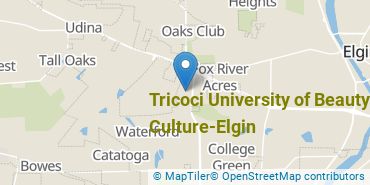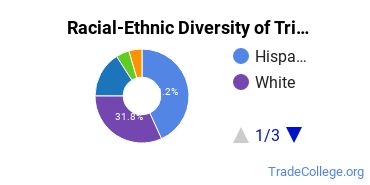Tricoci University of Beauty Culture-Elgin Trade Programs
Tricoci University of Beauty Culture-Elgin is a private for-profit institution located in Elgin, Illinois. The location of Tricoci Elgin is great for students who prefer living in an urban area.
Featured schools near , edit
Where Is Tricoci University of Beauty Culture-Elgin?

Contact details for Tricoci Elgin are given below.
| Contact Details | |
|---|---|
| Address: | 264 South Randall Road, Elgin, IL 60123-9412 |
| Phone: | 630-528-3330 |
| Website: | www.tricociuniversity.edu |
Can I Afford Tricoci Elgin?
Student Loan Debt
It's not uncommon for college students to take out loans to pay for school. In fact, almost 66% of students nationwide depend at least partially on loans. At Tricoci Elgin, approximately 75% of students took out student loans averaging $10,505 a year. That adds up to $42,020 over four years for those students.
Tricoci University of Beauty Culture-Elgin Undergraduate Student Diversity

Gender Diversity
Of the 42 full-time undergraduates at Tricoci Elgin, 2% are male and 98% are female.

Racial-Ethnic Diversity
The racial-ethnic breakdown of Tricoci University of Beauty Culture-Elgin students is as follows.

| Race/Ethnicity | Number of Grads |
|---|---|
| Asian | 4 |
| Black or African American | 11 |
| Hispanic or Latino | 5 |
| White | 20 |
| International Students | 0 |
| Other Races/Ethnicities | 2 |
Tricoci University of Beauty Culture-Elgin Trade School Concentrations
The table below shows the number of awards for each concentration.
| Major | Basic Certificate | Undergraduate Certificate | TOTAL |
|---|---|---|---|
| Aesthetician/Esthetician & Skin Care Specialist | 46 | 0 | 46 |
| General Cosmetology/Cosmetologist | 0 | 32 | 32 |
| TOTAL | 46 | 32 | 78 |
References
*The racial-ethnic minorities count is calculated by taking the total number of students and subtracting white students, international students, and students whose race/ethnicity was unknown. This number is then divided by the total number of students at the school to obtain the racial-ethnic minorities percentage.
More about our data sources and methodologies.
Featured Schools
 Request Info
Request Info
|
Southern New Hampshire University You have goals. Southern New Hampshire University can help you get there. Whether you need a bachelor's degree to get into a career or want a master's degree to move up in your current career, SNHU has an online program for you. Find your degree from over 200 online programs. Learn More > |
